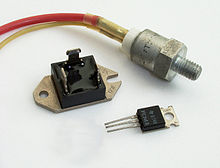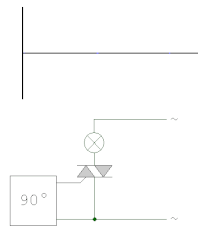Triac
Triac is an abbreviation for Tri ode for A lternating C urrent . The terms bi- directional thyristor triode or symistor can also be found in German. It is an electronic component with a semiconductor layer structure , which in principle represents an anti-parallel connection of two thyristors . This makes it possible to switch alternating current, whereas a single thyristor can only switch in one direction and thus acts like a diode when switched on . The triac is ignited via the gate and remains conductive until the holding current is undershot.
construction
A triac has a control electrode G (English gate ) and two main electrodes H1 and H2 (in English MainTerminal , MT1 and MT2) whereby the main electrode H2 (MT2) is usually directly connected to the housing. So that one control connection is sufficient for the two thyristors, two ignition or auxiliary thyristor sections are built into the triacs so that it can be switched to the low-resistance state with a positive and negative control pulse.
The analogy of the anti-parallel thyristors suggests that H1 (MT1) and H2 (MT2) are equivalent and can be exchanged as desired; However, this is not the case, since the internal structure is asymmetrical and H1 (MT1), as also indicated in the structure diagram, has a direct connection to the area of the gate on the semiconductor crystal and thus serves as a reference potential for the gate. The control current therefore always refers to H1 (MT1). A triac can be triggered with a positive as well as a negative gate current. The gate voltage required for this is in the range of the forward voltage of PN silicon diodes; Depending on the gate current and rail resistance , a few volts are necessary for this. However, it must be noted that the ignition sensitivity depends on the one hand on the gate current polarity and on the polarity at H1 (MT1) and H2 (MT2). The types of ignition are designated with I +, I−, III + and III− in relation to the associated output characteristic. Triacs usually have the greatest ignition sensitivity in ignition types I + and III−, ignition type I− requires a slightly higher and III + a significantly higher gate current for ignition.
3-quadrant TRIACs only ignite in the first three quadrants, not in ignition type III +. These are available for direct control via logic modules with a lower gate current (known as logic level ) or with improved extinguishing properties especially for inductive loads (known as snubberless, as they can be used without a snubber and the other necessary components).
If the specified ignition current of the TRIAC is undershot in terms of size or rate of rise, this can result in the ignition not spreading quickly enough throughout the semiconductor crystal. As a result, the load current sometimes only flows through partial areas of the crystal and can lead to local overheating and thus to weakening and destruction of the component. Due to the same mechanism, the rate of increase of the load current (also referred to as , with : instantaneous value of the load current and : time) must be kept below a specified value.
Triacs cannot be made for very large currents, which is why individual thyristors are still used in the field of power electronics .
Opto-triac
The opto-triac (also called photo-triac ) consists of two anti-parallel photo-thyristors that are optically switched on. Instead of the control electrode, a light-emitting diode is used to flood the pn junctions with charge carriers via the photoelectric effect and thus make them conductive. This represents a possibility to establish a galvanic separation between the control and load circuit, whereby loads such as z. B. the incandescent lamps operated with mains voltage of a light organ can be controlled without the mains voltage posing a risk for the control circuit.
Applications
The areas of application are mainly in the area of phase control as a typical variant of the power setting in the AC voltage range, such as for brightness control of incandescent lamps ( dimmers ), light organs or speed control of universal motors . The latter are z. B. used very often in power tools , electromotive household appliances and much more, where low-loss speed setting and high starting torques are required. Opto-Triacs are used in semiconductor relays , where they are used for electrically isolated switching of the actual switching element (power thyristors or triac). Due to their compact design, low production costs and the fact that an insulation voltage of any desired level can be achieved through the use of light guides , opto-triacs have replaced the ignition transformers previously used for this purpose . In rare cases - when only a small current (up to approx. 100 mA) has to be switched - an opto-triac can also be used to switch the load directly.
See also
Web links
- Electronics Compendium: Triac - Triode Alternating Current Switch . Retrieved on Feb. 23, 2009.






